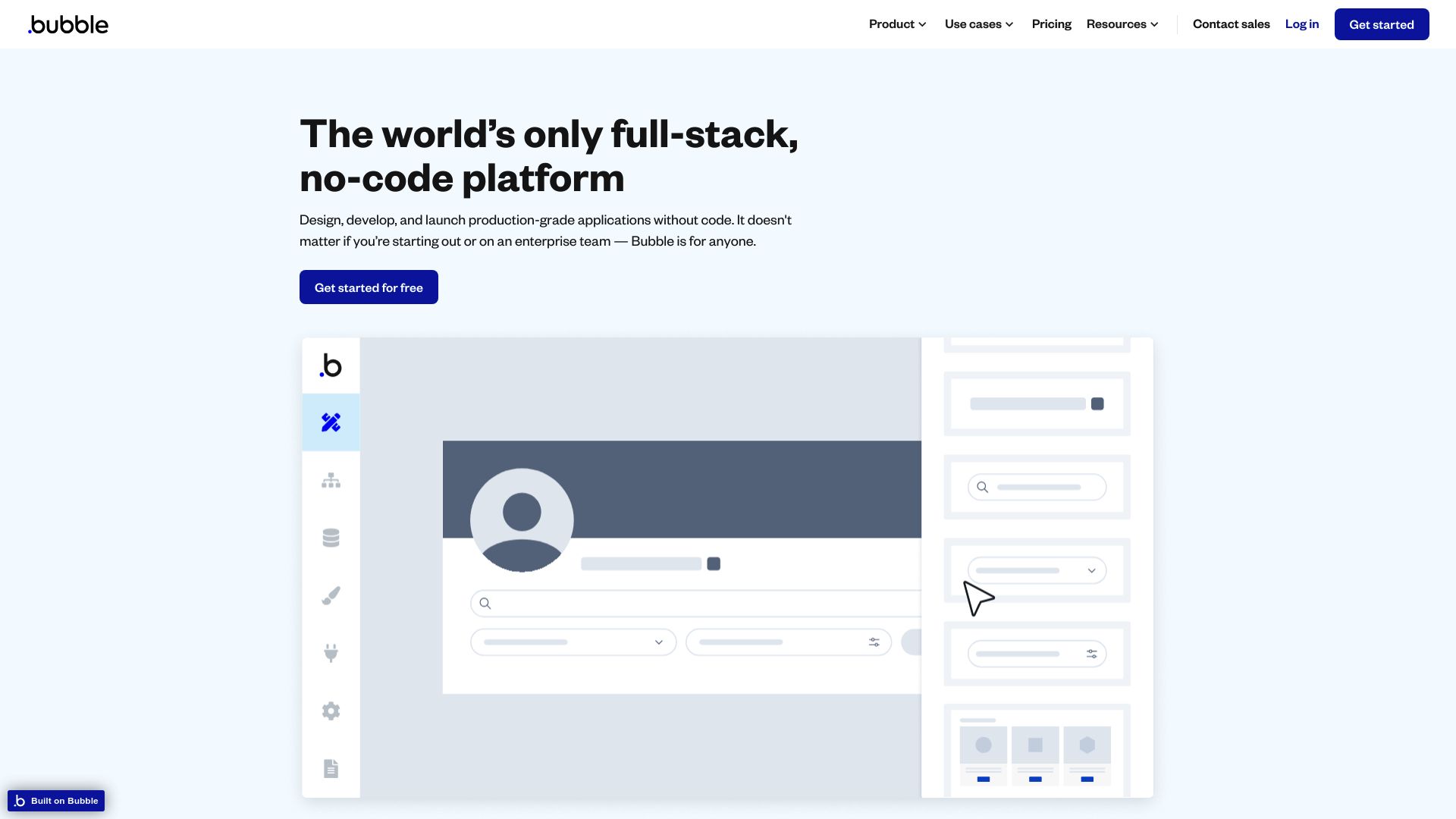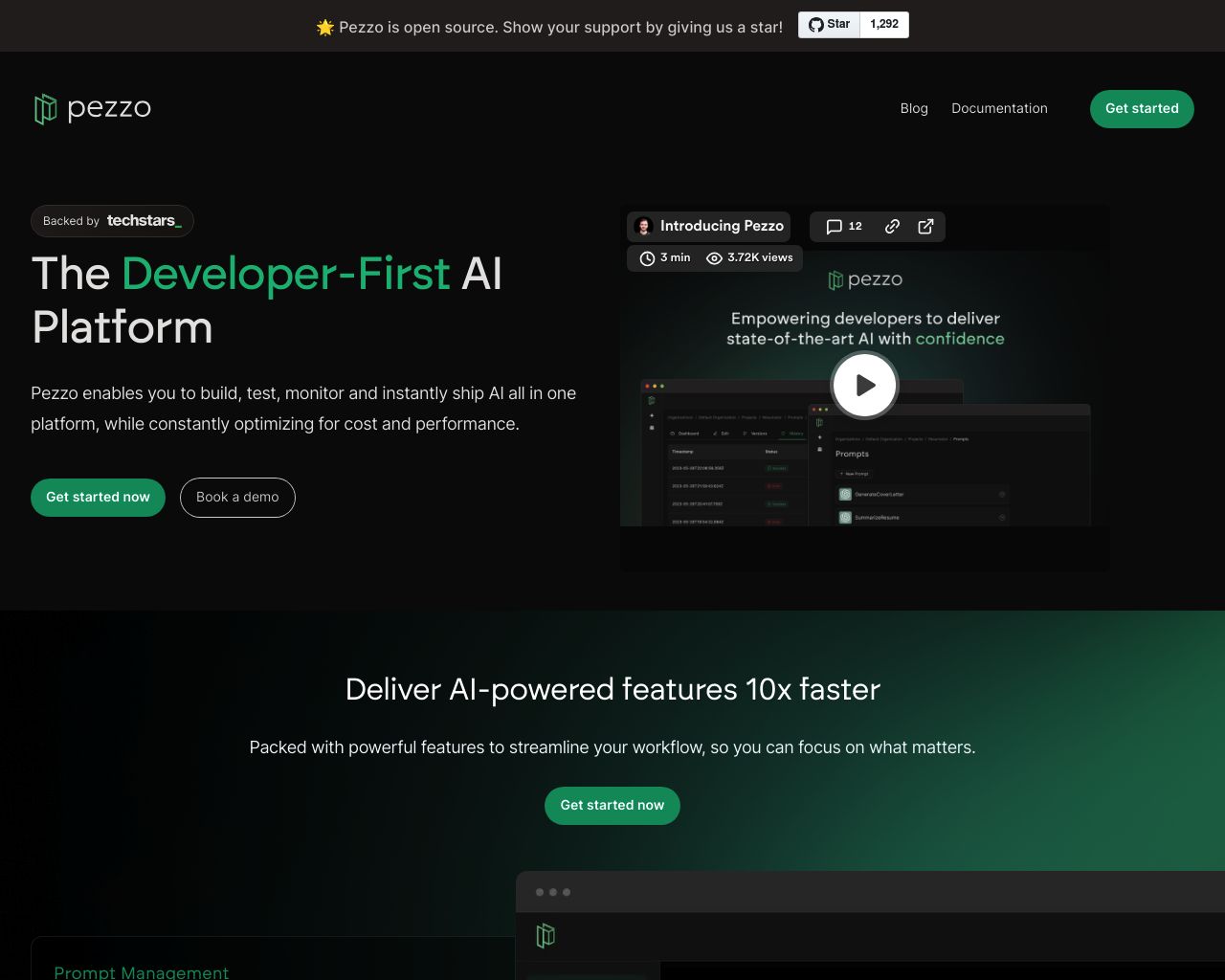Bubble vs. Pezzo: AI Development Platform Face-Off
AI development platforms are transforming how businesses create and deploy intelligent applications. Bubble vs. Pezzo, and SmythOS each offer unique approaches to software development and AI integration. Bubble simplifies web application creation with its no-code visual interface, while Pezzo streamlines AI development through efficient prompt management.
SmythOS, however, combines the strengths of both while addressing their limitations, offering a comprehensive platform for creating and deploying AI agents with unparalleled ease and flexibility. This comparison explores how these platforms stack up in features, usability, and overall value for developers, business leaders, and AI enthusiasts seeking to harness the power of artificial intelligence in their projects.
Bubble Overview
Bubble empowers users to create web applications without coding. Its visual interface allows dragging and dropping elements to build fully functional apps, making software development accessible to non-programmers. Bubble caters to entrepreneurs, small businesses, and enterprises seeking to rapidly prototype and launch web-based products.
The platform’s standout feature is its no-code approach, enabling users to construct complex applications through a visual programming language. Bubble’s workflow editor facilitates creating intricate business logic, while its responsive design capabilities ensure apps function seamlessly across devices. The platform also supports database management, user authentication, and third-party integrations, providing a comprehensive solution for web application development.
Bubble empowers users to create web applications without coding. Its visual interface allows dragging and dropping elements to build fully functional apps, making software development accessible to non-programmers.


Bubble’s integration capabilities extend to AI services, allowing users to incorporate advanced functionalities like natural language processing and machine learning into their applications. Through plugins and API connectors, developers can leverage AI tools such as OpenAI’s GPT models to enhance their apps with intelligent features like chatbots and content generation.
While Bubble excels in simplifying web application development, it has limitations. The platform’s learning curve can be steep for complex projects, and performance may lag compared to traditionally coded applications. Additionally, heavy customization might require workarounds or plugins, potentially impacting the app’s efficiency. Despite these challenges, Bubble’s continuous updates and active community support help mitigate many of these issues, solidifying its position as a leading no-code development platform.
Pezzo Overview
Pezzo revolutionizes AI development with its open-source toolkit designed for efficiency and collaboration. The platform streamlines prompt design, management, and publishing, empowering developers to create sophisticated AI solutions rapidly.


Pezzo’s standout features include effortless prompt and version management, significantly accelerating AI solution delivery. The platform offers conversion-boosting capabilities through A/B testing and experiments, allowing users to optimize their AI models’ performance. Cost optimization tools help maximize efficiency, potentially saving up to 50% on AI operations.
Pezzo’s standout features include effortless prompt and version management, significantly accelerating AI solution delivery.
Advanced features like real-time trading, charts, and comprehensive troubleshooting capabilities enhance the AI development experience. Pezzo provides detailed observability into AI operations, reducing debugging time and improving team understanding of AI processes.
While Pezzo excels in many areas, it lacks some features found in more comprehensive platforms. It doesn’t offer hosted AI agents or autonomous agent capabilities, limiting its use for certain advanced AI applications. Additionally, the platform doesn’t provide built-in multimodal support or a hosted vector database, which may be essential for some users.
Despite these limitations, Pezzo’s focus on collaboration, transparency, and efficient prompt management makes it a valuable tool for AI developers seeking to streamline their workflow and improve productivity in AI development projects.
Feature Comparison
Bubble and Pezzo offer distinct approaches to software development and AI integration, each with its own strengths and limitations. Bubble excels in no-code web application development, providing a visual interface for building complex applications without writing code. Its drag-and-drop editor and responsive design capabilities enable rapid prototyping and deployment of web-based products. Bubble supports integration with AI services through APIs and plugins, allowing users to incorporate features like chatbots and content generation.
Pezzo, on the other hand, focuses specifically on AI development, offering an open-source toolkit for streamlining prompt design, management, and publishing. Pezzo’s strength lies in its ability to accelerate AI solution delivery through efficient prompt and version management. The platform provides advanced features for optimizing AI performance, including A/B testing and cost optimization tools. Pezzo also offers detailed observability into AI operations, enhancing transparency and reducing debugging time.
However, both platforms have notable gaps in their core components and security features. Bubble lacks native support for AI agents, autonomous operations, and advanced AI-specific features like multimodal capabilities or explainable AI. While it offers basic security measures, it doesn’t provide specialized AI alignment or advanced encryption options. Pezzo, while more focused on AI development, doesn’t offer hosted agents or autonomous agent capabilities, limiting its use for certain advanced AI applications. Additionally, Pezzo doesn’t provide a hosted vector database or built-in multimodal support, which may be essential for some AI developers.
Feature Comparison Table
| Bubble | Pezzo | SmythOS | |
|---|---|---|---|
| CORE FEATURES | |||
| Hosted Agents (Dev, Production) | ✅ | ❌ | ✅ |
| Visual Builder | ✅ | ❌ | ✅ |
| No-Code Options | ✅ | ❌ | ✅ |
| Memory & Context | ❌ | ❌ | ✅ |
| Autonomous Agents | ❌ | ❌ | ✅ |
| Explainability & Transparency | ❌ | ✅ | ✅ |
| Multimodal | ❌ | ✅ | ✅ |
| Multi-Agent Collaboration | ❌ | ✅ | ✅ |
| Bulk Work | ❌ | ✅ | ✅ |
| Agent Work Scheduler | ❌ | ✅ | ✅ |
| SECURITY | |||
| Constrained Alignment | ❌ | ❌ | ✅ |
| IP Control | ❌ | ❌ | ✅ |
| COMPONENTS | |||
| Huggingface AIs | ❌ | ✅ | ✅ |
| Classifiers | ❌ | ✅ | ✅ |
| Data Lakes | ✅ | ❌ | ✅ |
| DEPLOYMENT OPTIONS (EMBODIMENTS) | |||
| Deploy as API | ❌ | ✅ | ✅ |
| Deploy as Scheduled Agent | ❌ | ❌ | ✅ |
| DATA LAKE SUPPORT | |||
| Hosted Vector Database | ❌ | ❌ | ✅ |
| Sitemap Crawler | ❌ | ❌ | ✅ |
| YouTube Transcript Crawler | ❌ | ❌ | ✅ |
| URL Crawler | ❌ | ✅ | ✅ |
Best Alternative to Bubble and Pezzo
SmythOS emerges as the superior alternative to Bubble and Pezzo, offering a comprehensive platform for AI agent development and deployment. Our solution combines the best of both worlds, providing an intuitive visual builder like Bubble with advanced AI capabilities that surpass Pezzo’s offerings.
Unlike Bubble’s limited AI integration options, SmythOS delivers a full suite of AI agent features. We offer hosted agents for both development and production environments, enabling seamless testing and deployment. Our platform supports autonomous agents with memory and context capabilities, allowing for more sophisticated and context-aware AI interactions than either Bubble or Pezzo can provide.
SmythOS emerges as the superior alternative to Bubble and Pezzo, offering a comprehensive platform for AI agent development and deployment.
While Pezzo focuses on prompt management and optimization, SmythOS goes further by offering multi-agent collaboration and a wide range of deployment options. We enable users to create complex AI systems that can work together, tackling intricate problems across various domains. Our platform also supports multimodal interactions, handling text, voice, and visual data—a feature notably absent in both Bubble and Pezzo.
Security is paramount in AI development, and SmythOS doesn’t compromise. We implement constrained alignment to ensure AI behavior aligns with organizational goals and ethical guidelines—a critical feature missing in both Bubble and Pezzo. Our platform also offers advanced data encryption and IP control, providing enterprise-grade security that surpasses the basic measures offered by our competitors.
In terms of ease of use and versatility, SmythOS stands out with its no-code options and visual builder, making AI development accessible to users of all skill levels. Whether you’re a seasoned developer or a business user with no coding experience, our platform empowers you to create sophisticated AI solutions quickly and efficiently. With SmythOS, we’ve eliminated the limitations of Bubble’s web-centric approach and Pezzo’s narrow focus on prompt management, offering a truly comprehensive solution for modern AI development and deployment.
Conclusion
Bubble, Pezzo, and SmythOS each offer unique approaches to software development and AI integration. Bubble excels in no-code web application creation, enabling users to build complex apps visually. Pezzo focuses on streamlining AI development with efficient prompt management and optimization tools. However, SmythOS emerges as the superior choice, combining the strengths of both while addressing their limitations.
SmythOS offers a comprehensive platform for creating and deploying AI agents with unparalleled ease and flexibility. Its drag-and-drop interface rivals Bubble’s simplicity, while its AI capabilities surpass Pezzo’s offerings. SmythOS supports multimodal interactions, autonomous operations, and advanced features like explainable AI, which are absent in both Bubble and Pezzo.
Unlike its competitors, SmythOS provides a complete ecosystem for AI development and deployment. It offers hosted agents, multiple environments, and extensive integration options, including support for various AI models and APIs. This versatility, combined with robust security features and scalability, makes SmythOS ideal for businesses of all sizes and technical expertise levels.
To experience the full potential of AI-driven development, explore SmythOS’s diverse range of AI-powered agent templates. These templates cover multiple business categories and offer a practical starting point for your AI journey. For those ready to transform their workflows with intelligent agents, we invite you to create a free SmythOS account and start building unlimited AI agents at no cost. Discover how SmythOS can revolutionize your approach to AI integration and development, providing a powerful yet accessible platform for the future of software creation.
Last updated:
Disclaimer: The information presented in this article is for general informational purposes only and is provided as is. While we strive to keep the content up-to-date and accurate, we make no representations or warranties of any kind, express or implied, about the completeness, accuracy, reliability, suitability, or availability of the information contained in this article.
Any reliance you place on such information is strictly at your own risk. We reserve the right to make additions, deletions, or modifications to the contents of this article at any time without prior notice.
In no event will we be liable for any loss or damage including without limitation, indirect or consequential loss or damage, or any loss or damage whatsoever arising from loss of data, profits, or any other loss not specified herein arising out of, or in connection with, the use of this article.
Despite our best efforts, this article may contain oversights, errors, or omissions. If you notice any inaccuracies or have concerns about the content, please report them through our content feedback form. Your input helps us maintain the quality and reliability of our information.
